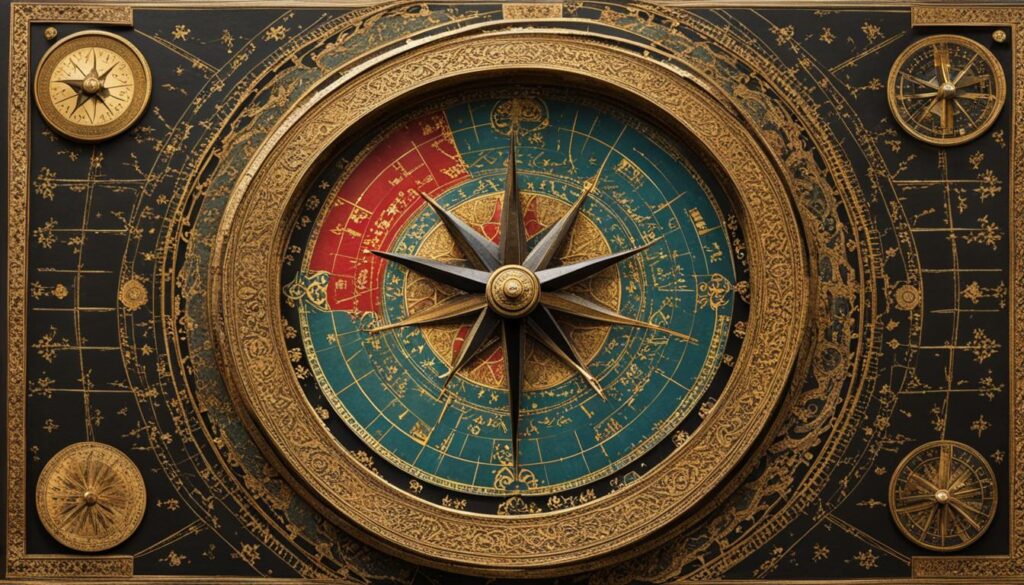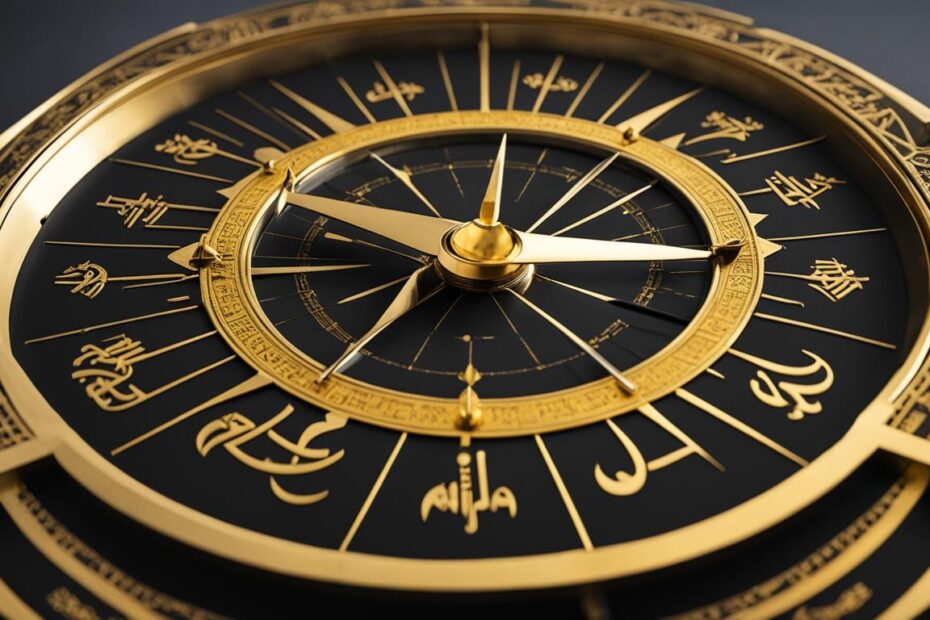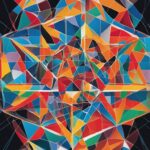A Qibla compass is a convenient and accurate tool used by Muslims to determine the direction of the Qibla, the direction towards the Kaaba in Mecca. It plays a crucial role in helping individuals align themselves properly while offering their prayers, ensuring that their worship is directed towards the Holy Kaaba. Whether using a physical compass or a mobile app, a Qibla compass is an essential tool for Muslims to practice their faith.
Key Takeaways:
- A Qibla compass is used by Muslims to find the direction of the Qibla, the Kaaba in Mecca.
- It ensures proper alignment during prayers and helps Muslims fulfill their religious obligations.
- There may be slight variations in Qibla directions among different Islamic sects.
- Qibla compasses can be made from various materials, including metal, plastic, or digital components.
- Advancements in technology have led to the development of Qibla finder apps, making it easier for Muslims to determine the Qibla direction.
Understanding the Qibla and Its Significance
The Qibla is a fundamental concept in Islam, representing the direction that Muslims face during their prayers. It symbolizes the unity of the Muslim community and their alignment towards the center of Islam, the Holy Kaaba in Mecca. The Qibla holds great religious and symbolic significance, as it signifies the connection between Muslims and their Creator. By facing the Qibla during prayer, Muslims demonstrate their devotion and submission to Allah. The Qibla direction is an integral part of the Islamic faith, ensuring that prayers are offered in the correct manner.
As Muslims worldwide face different geographical locations, determining the Qibla direction can be challenging. To address this, various prayer tools have been developed to aid Muslims in finding the Qibla direction accurately. One such tool is the Qibla compass, which provides a simple and practical solution. By aligning the compass needle with the Qibla direction, individuals can ensure that they are facing the Holy Kaaba while offering their prayers. The Qibla compass serves as a Muslim prayer tool, facilitating the fulfillment of religious obligations and fostering a stronger connection with Allah.
Importance of the Holy Kaaba
“The Kaaba is the holiest site in Islam, serving as the focal point for all Muslims around the world. It was built by the Prophet Ibrahim and his son Ismail and has been a place of worship for centuries. Muslims believe that the Kaaba is the house of Allah, and facing it during prayer is a fundamental aspect of their faith. The Holy Kaaba represents the unity of Muslims and serves as a symbol of their devotion and submission to Allah.”
While the Qibla direction is generally towards the Kaaba in Mecca, there can be variations among different Islamic sects. These variations arise due to differences in calculations and methods used to determine the Qibla direction. However, the overall objective remains the same – to face the Kaaba while performing prayers, regardless of the minor differences in direction. The Qibla direction, along with the Holy Kaaba, represents the central pillar of the Islamic faith and plays a vital role in the spiritual lives of Muslims worldwide.
| Prayer Tools | Usage |
|---|---|
| Qibla Compass | Align the compass needle with the Qibla direction to determine the correct prayer direction. |
| Sun Position | Observe the position of the sun to estimate the Qibla direction. |
| Stick and Shadow Method | Make observations with a stick and its shadow to determine the Qibla direction. |
| Sundials | Use traditional sundials with specific markings to find the Qibla direction based on the sun’s position. |
Qibla compasses can be made from various materials, including metal, plastic, or digital components in the form of smartphone applications. Traditional compasses often have clear markings indicating the Qibla direction, while digital applications utilize GPS technology to provide accurate and real-time information on the direction towards Mecca. The choice of material for a Qibla compass depends on personal preference and accessibility to different tools. However, the ultimate goal remains the same – to determine the Qibla direction and establish a connection with the Holy Kaaba during prayer.
Over time, prayer tools have evolved to cater to the needs of modern Muslims. Traditional compasses have been replaced by digital applications, making it more convenient for individuals to find the Qibla direction using their smartphones. These apps often come with additional features such as prayer times, mosque locators, and Islamic calendars, providing comprehensive support for practicing Muslims. The advancements in technology have made it easier for Muslims to stay connected to their faith and accurately determine the Qibla direction, emphasizing the continuous evolution of prayer tools.
Using a Qibla Compass for Prayer
When it comes to prayer, using a Qibla compass is a practical and important tool for Muslims. By utilizing a Qibla compass, individuals can accurately determine the direction of the Qibla, the holy direction towards the Kaaba in Mecca. This ensures that their prayers are properly aligned and directed towards the holiest site in Islam.
To use a Qibla compass for prayer, individuals need to place the compass flat on a steady surface, ensuring that the needle points towards the correct Qibla direction. The compass provides clear guidance, allowing Muslims to turn and face the Holy Kaaba while offering their prayers. This alignment is essential for fulfilling the religious obligation of Salah (prayer) and maintaining a strong connection with Allah.
Qibla compasses come in various forms, including traditional physical compasses and digital applications on smartphones. Regardless of the type, these compasses serve as reliable tools for determining the Qibla direction, making it easier for Muslims to practice their faith wherever they may be. By using a Qibla compass during prayer, individuals can ensure that their worship is in accordance with Islamic teachings, providing them with a sense of peace, spirituality, and devotion.
| Benefits of Using a Qibla Compass for Prayer | Advantages of Using a Qibla Compass App |
|---|---|
|
|
Using a Qibla compass for prayer is not only a practical way to determine the Qibla direction, but it also symbolizes the unity of the Muslim community. By facing the same direction towards the Kaaba, Muslims worldwide express their connection and devotion to Islam. It serves as a reminder of the central focus of their faith and the importance of aligning their actions with Islamic principles.
Variations in Qibla Directions Among Sects
While the general Qibla direction is towards the Kaaba in Mecca, there may be slight variations depending on an individual’s location and the interpretation of different Islamic sects. These variations arise due to differences in calculations and methods used to determine the Qibla direction. However, the overall objective remains the same – to face the Kaaba while performing prayers, regardless of the minor differences in direction.
In some cases, variations in Qibla direction can be attributed to geographical factors. For example, individuals located in different regions may face a slightly different angle towards the Kaaba due to the curvature of the Earth. Additionally, variations can also arise from differences in religious rulings and scholarly interpretations within different Islamic sects. These variations reflect the diversity within the Muslim community and the different ways in which individuals adhere to their faith.
“The variations in Qibla directions among sects highlight the importance of unity within the Muslim community, as each individual strives to face the Kaaba in their prayers. Despite these minor differences, the underlying symbolism and devotion towards the Holy Kaaba remain consistent.”
It is important to note that these variations in Qibla direction do not detract from the significance and importance of facing the Kaaba during prayers. The Qibla serves as a unifying focal point for Muslims worldwide, symbolizing their connection to Islam, the Holy Kaaba, and their Creator. Regardless of the variations among sects, the ultimate goal for Muslims is to align themselves towards the Kaaba and offer their prayers with devotion and humility.
Table: Variations in Qibla Directions Among Islamic Sects
| Sect | Main Qibla Direction | Variations |
|---|---|---|
| Sunni | Towards the Kaaba in Mecca | Minimal variations based on geographical location |
| Shia | Towards the Kaaba in Mecca | Slight variations based on scholarly interpretations |
| Ibadi | Towards the Kaaba in Mecca | Slight variations based on geographical and historical considerations |
Table: Variations in Qibla Directions Among Islamic Sects
Main Prayer Tools
When it comes to practicing their faith, Muslims rely on various prayer tools to aid them in their devotion and ensure that their prayers are aligned with the Qibla, the direction of the Holy Kaaba in Mecca. The main prayer tool used by Muslims is the Qibla compass. This compass, whether physical or digital, provides accurate guidance on the Qibla direction and helps individuals align themselves properly during prayer.
Another commonly used prayer tool is the Qibla finder app. With the advancement of technology, these apps have become increasingly popular among Muslims. By utilizing GPS technology, these apps locate an individual’s position and provide real-time Qibla direction information, making it convenient for Muslims to determine the direction of Mecca, no matter where they are.
These prayer tools symbolize the importance of unity and connection within the Muslim community. By aligning themselves towards the Kaaba, Muslims demonstrate their devotion and their connection to the center of their faith. This symbolic act of facing the Qibla during prayer reinforces the sense of community among Muslims worldwide.
Table: Materials Used for Qibla Compasses
| Compass Type | Materials Used |
|---|---|
| Traditional Compass | Metal, Plastic |
| Digital Compass (App) | Smartphone hardware, Digital components |
“By using these prayer tools, individuals can ensure that their actions are in line with Islamic teachings and that their prayers are directed towards the Holy Kaaba.”
It’s important to note that there may be variations in the Qibla direction among different Islamic sects. These variations are due to differences in calculations and interpretations of religious texts. While the general direction is towards the Kaaba, these slight variations highlight the diversity within the Muslim faith while still emphasizing the common goal of directing prayers towards the Holy Kaaba.
Evolution of Qibla Compasses Over Time
Qibla compasses have undergone significant transformations over time, adapting to the needs and advancements in technology. Traditional compasses, made from metal or plastic, were commonly used to determine the Qibla direction. These compasses featured clear markings indicating the direction towards the Holy Kaaba in Mecca, enabling Muslims to align themselves properly during prayer.
However, with the rise of digital technology, Qibla finder apps have become increasingly popular among modern Muslims. These smartphone applications utilize GPS technology to accurately locate an individual’s position and provide real-time information on the Qibla direction. Users can simply download these apps and easily find the direction towards Mecca, making it more convenient to perform prayers no matter where they are.
Qibla finder apps offer additional features beyond just determining the Qibla direction. Users can access prayer times, mosque locators, and Islamic calendars, enhancing their overall prayer experience. These apps have become an essential tool for Muslim individuals who seek to stay connected to their faith and ensure accurate alignment during prayer.

Qibla Compass Evolution
| Traditional Compass | Qibla Finder App |
|---|---|
| Physical device | Smartphone application |
| Uses magnetism and markings for direction | Utilizes GPS technology for accurate real-time information |
| Portable and easy to use | Convenient and accessible on smartphones |
The evolution of Qibla compasses has made it easier for Muslims to maintain their religious practices and stay connected to their faith. These advancements in technology have provided a modern solution that combines convenience and accuracy, ensuring that individuals can confidently align themselves towards the Qibla direction during prayers.
Lesser-Known Prayer Tools
While the Qibla compass is the most widely recognized tool for determining the Qibla direction, there are lesser-known prayer tools that some individuals may use. These alternative methods may be employed by individuals who do not have access to a Qibla compass or prefer using traditional means to determine the Qibla direction.
Observing the Position of the Sun
One lesser-known prayer tool involves observing the position of the sun. By understanding the movements of the sun throughout the day, individuals can determine the approximate Qibla direction. This method requires knowledge of the sun’s rising and setting positions and the ability to make accurate estimations based on the time of day. While it may not provide the same level of precision as a Qibla compass, it can still serve as a helpful guide for those without access to other tools.
Using a Stick and Shadow
Another method involves using a stick and its shadow to determine the Qibla direction. By sticking a vertical pole or stick into the ground and observing its shadow, individuals can analyze the direction and length of the shadow to find the approximate Qibla direction. This method relies on understanding the angle and position of the sun and requires some basic measurements and calculations. While it may not be as accurate as a Qibla compass, it can still provide a reasonable estimate for prayer direction.
Traditional Sundials
In some cases, individuals may use traditional sundials to determine the Qibla direction. Sundials are timekeeping devices that use the shadow of a stationary object to indicate the time of day. By aligning the sundial with the sun and observing the shadow, individuals can estimate the Qibla direction. However, this method requires proper alignment, precise calculations, and a clear understanding of how sundials work. While it may not be a widely used method in modern times, it demonstrates the resourcefulness and ingenuity of those who may not have access to more advanced tools.
| Prayer Tool | Purpose | Accuracy |
|---|---|---|
| Qibla Compass | To determine the exact Qibla direction | High |
| Observing the Position of the Sun | To estimate the approximate Qibla direction | Medium |
| Using a Stick and Shadow | To estimate the approximate Qibla direction | Medium |
| Traditional Sundials | To estimate the approximate Qibla direction | Low |
While these lesser-known prayer tools may not provide the same level of accuracy as a Qibla compass, they can still serve as useful alternatives for individuals who do not have access to or prefer not to use a compass. These tools demonstrate the resourcefulness and adaptability of individuals in practicing their faith and finding the Qibla direction to ensure their prayers are directed towards the Holy Kaaba.
Importance of Accurately Finding the Qibla Direction
Accurately finding the Qibla direction is crucial for Muslims to ensure that their prayers are directed towards the Holy Kaaba in Mecca, the holiest site in Islam. It is a fundamental aspect of Salah (prayer) and plays a significant role in fulfilling one’s religious obligations. By using a Qibla compass or other prayer tools, Muslims can align themselves properly and maintain a strong connection with their faith.
When Muslims pray, they face the Qibla, symbolizing their unity and alignment towards the center of Islam. The Qibla direction represents the connection between Muslims and their Creator, emphasizing their devotion and submission to Allah. Accurately finding the Qibla direction ensures that prayers are offered with the utmost sincerity and in accordance with Islamic teachings.
There may be slight variations in the Qibla direction among different Islamic sects and based on an individual’s location. These differences arise due to variations in calculations and methods used to determine the Qibla direction. However, regardless of these minor deviations, the primary objective remains the same – to face the Kaaba while performing prayers, reflecting the unity and shared beliefs of Muslims worldwide.
| Prayer Tools | Usage | Symbolism |
|---|---|---|
| Qibla Compass | A physical or digital tool that helps determine the Qibla direction. | Represents the guidance and accuracy required to align oneself towards the Holy Kaaba. |
| Sun Position | Using the position of the sun to estimate the Qibla direction. | Relies on natural elements and serves as a reminder of the Creator’s presence in the universe. |
| Stick and Shadow | Making observations with a stick and shadow to find the Qibla direction. | Highlights resourcefulness and the ability to adapt to different situations in the absence of traditional tools. |
Accurately finding the Qibla direction is a fundamental aspect of Muslim prayer. It ensures that prayers are directed towards the Holy Kaaba, reflecting unity, devotion, and submission to Allah. Different prayer tools, such as Qibla compasses, sun positions, and stick and shadow observations, provide Muslims with practical methods to determine the Qibla direction and maintain a strong connection with their faith.
The Convenience of Qibla Finder Apps
Qibla finder apps have revolutionized the way Muslims find the Qibla direction, providing them with a convenient and user-friendly solution. These apps utilize GPS technology to accurately locate an individual’s position and provide real-time Qibla direction information. With just a few taps on their smartphones, Muslims can easily determine the direction towards Mecca, making it easier to perform their prayers no matter where they are.
| Benefits of Qibla Finder Apps | Features |
|---|---|
| 1. Accurate Qibla Direction | Qibla finder apps use GPS technology to ensure precise alignment towards Mecca. |
| 2. Real-time Updates | Apps provide up-to-date Qibla direction information based on the user’s location. |
| 3. User-friendly Interface | Intuitive design and easy navigation make it simple for users to find the Qibla direction quickly. |
| 4. Additional Features | Many apps offer supplementary features such as prayer times, mosque locators, and Islamic calendars. |
Qibla finder apps have become an indispensable tool for Muslims, especially when traveling or in unfamiliar environments. They eliminate the need to carry a physical compass and provide peace of mind, knowing that the Qibla direction can be easily determined at any time. These apps cater to the modern lifestyle, allowing Muslims to stay connected to their faith wherever they go.
“Qibla finder apps make it convenient for me to find the Qibla direction whenever I’m traveling or away from home. I can rely on the app for accurate information and perform my prayers with ease.” – A satisfied user
Enhancing Faith and Connection through Prayer Tools
Prayer tools such as the Qibla compass play a significant role in strengthening the faith and connection of Muslims to their religion. By using these tools, individuals can ensure that their actions are in line with Islamic teachings and that their prayers are directed towards the Holy Kaaba. The accurate determination of the Qibla direction contributes to a deeper sense of spirituality and devotion, allowing Muslims to enhance their connection with Allah and their community.
One of the main prayer tools used by Muslims is the Qibla compass. This tool helps individuals find the Qibla direction, ensuring that they face towards the Holy Kaaba while offering their prayers. The Qibla compass serves as a physical reminder of the unity and alignment of the Muslim community, as it symbolizes their connection to the center of Islam. By using the Qibla compass, Muslims can fulfill the essential pillar of Salah (prayer) with the proper alignment and devotion.
Over time, prayer tools like the Qibla compass have evolved to cater to the needs and convenience of modern Muslims. Traditional compasses have been replaced by digital applications, such as Qibla finder apps, making it easier for individuals to determine the Qibla direction using their smartphones. These apps not only provide accurate and real-time information on the direction towards Mecca, but also offer additional features such as prayer times, mosque locators, and Islamic calendars.
The Importance of the Qibla Angle
Within the realm of prayer tools, an important concept to understand is the Qibla angle. The Qibla angle refers to the angle at which an individual needs to face in order to align themselves with the direction towards the Holy Kaaba. It accounts for the curvature of the Earth and the specific location of the individual. The Qibla angle varies depending on the geographical coordinates of a person’s location and can be calculated using various methods, including mathematical formulas and digital applications.
Understanding and utilizing prayer tools like the Qibla compass not only helps Muslims fulfill their religious obligations, but also fosters a deeper sense of spirituality and connection. By aligning their prayers towards the Holy Kaaba, Muslims symbolically align themselves with the center of Islam and the larger Muslim community around the world. These prayer tools serve as reminders of the unity and collective devotion of Muslims, bringing them closer to their faith and enhancing their spiritual journey.
Conclusion
A Qibla compass is a vital Muslim prayer tool that enables accurate determination of the Islamic prayer direction towards the Holy Kaaba in Mecca. Whether using a traditional compass or a digital Qibla finder app, these tools provide convenience and accuracy, ensuring that Muslims align themselves properly while offering their prayers.
By utilizing these prayer tools, individuals can enhance their faith, strengthen their connection to Islam, and experience a deeper sense of spirituality. The Qibla compass and other prayer tools symbolize the unity of the Muslim community and their alignment towards the center of Islam.
While there may be slight variations in the Qibla direction among different Islamic sects, the overall objective remains the same – to face the Kaaba while performing prayers, regardless of minor differences in direction. Qibla compasses can be made using various materials, including metal, plastic, or digital components as smartphone applications.
Over time, Qibla compasses have evolved to cater to the needs of modern Muslims. Digital Qibla apps with additional features like prayer times and mosque locators have made it easier for Muslims to stay connected to their faith and accurately determine the Qibla direction. Although the Qibla compass is the most widely recognized tool, there are lesser-known methods such as using the position of the sun or traditional sundials that some individuals may employ.
FAQ
What is a Qibla compass?
A Qibla compass is a handy tool used by Muslims to determine the direction of the Qibla, the direction towards the Kaaba in Mecca. It helps individuals align themselves properly while offering their prayers.
Why is finding the Qibla direction important?
Finding the correct Qibla direction ensures that Muslims are facing the Holy Kaaba while praying, which holds great religious and symbolic significance in Islam.
How does a Qibla compass work?
A Qibla compass is placed flat, and the needle aligns towards the Qibla direction, providing guidance for individuals to turn and face the Holy Kaaba while offering their prayers.
Can the Qibla direction vary among different Islamic sects?
Yes, slight variations in Qibla direction can occur depending on an individual’s location and the interpretation of different Islamic sects. The overall objective remains the same – to face the Kaaba while performing prayers.
What materials are used for Qibla compasses?
Qibla compasses can be made using various materials such as metal, plastic, or even digital components like smartphone applications.
How have Qibla compasses evolved over time?
Traditional compasses have been replaced by digital applications, making it more convenient for individuals to find the Qibla direction using their smartphones. These apps often come with additional features like prayer times and mosque locators.
Are there other prayer tools to determine the Qibla direction?
Yes, alternative methods such as using the position of the sun, observations with a stick and shadow, or traditional sundials can be used by individuals without access to a Qibla compass.
Why is accurately finding the Qibla direction important for Muslims?
Accurately finding the Qibla direction ensures that Muslims’ prayers are directed towards the Holy Kaaba, allowing them to fulfill one of the essential pillars of Islam with proper alignment and devotion.
What are Qibla finder apps?
Qibla finder apps utilize GPS technology to accurately locate an individual’s position and provide real-time Qibla direction information, making it easier to perform prayers no matter where they are.
How do prayer tools such as Qibla compasses enhance faith and connection?
By using prayer tools like Qibla compasses, individuals can ensure their actions are in line with Islamic teachings, strengthening their connection to Islam and deepening their sense of spirituality in daily life.








